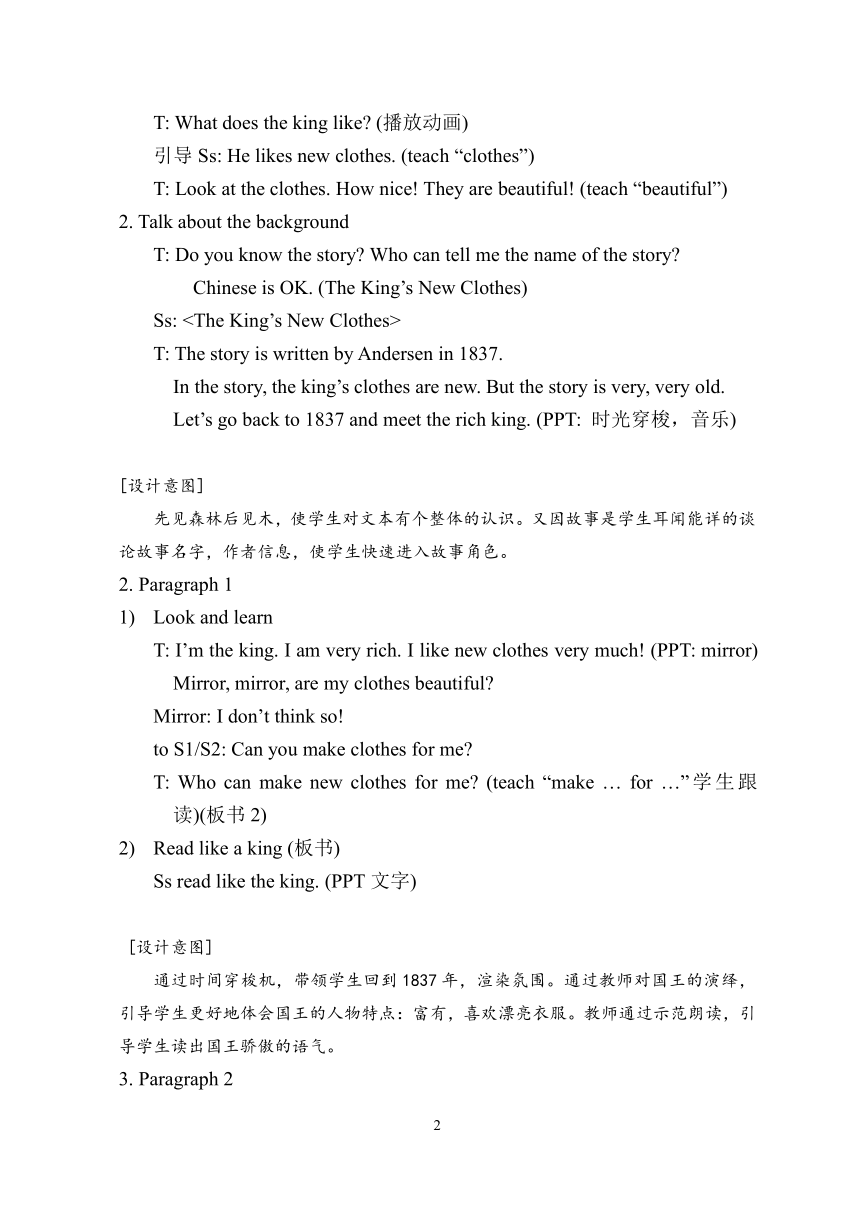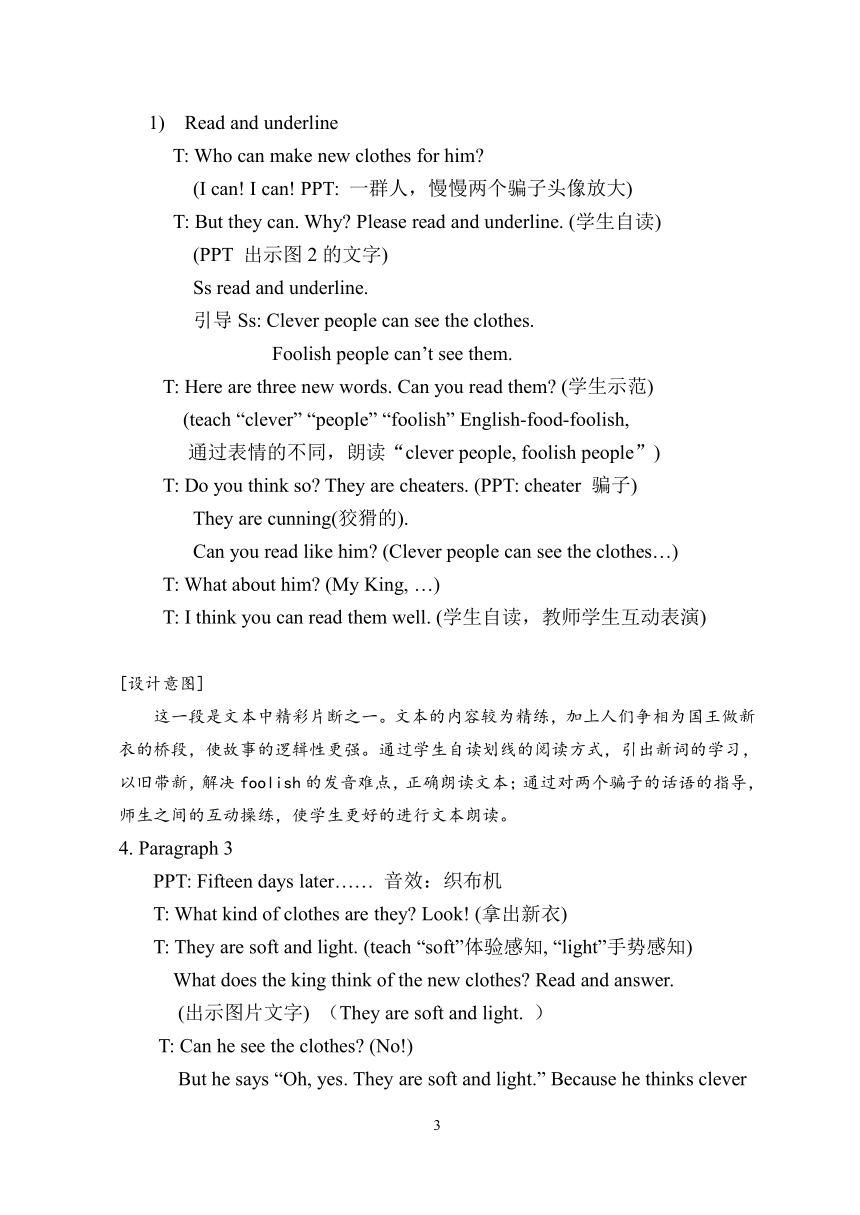Unit1 The king’s new clothes Story time 教案
文档属性
| 名称 | Unit1 The king’s new clothes Story time 教案 |  | |
| 格式 | zip | ||
| 文件大小 | 11.6KB | ||
| 资源类型 | 教案 | ||
| 版本资源 | 牛津译林版 | ||
| 科目 | 英语 | ||
| 更新时间 | 2019-12-26 09:08:38 | ||
图片预览



文档简介
The
King’s
New
Clothes
Ⅰ.
Teaching
content:
绘本New
Clothes>
Ⅱ.
Teaching
aims
and
demands:
1.
学习单词和词组:rich,
clothes,
king,
clever,
foolish,
light,
soft,
beautiful,
wearing,
理解意思,能听懂,能读熟。
2.
初步感知句型:…
can
…能听懂,会读,会说。
3.
能正确理解故事内容,有感情地朗读故事。
4.
让学生体验故事表演的快乐,明白为人要诚实,待人要真诚。
Ⅲ.
Teaching
keys:
1.
单词clothes,
foolish,
wearing的发音。
2.
描述服装的形容词。
3.
故事中人物语气的朗读。
Ⅳ.
Teaching
difficulties:
在正确理解故事的基础上,有感情地朗读、表演故事内容。
Ⅴ.
Teaching
aids:
头饰,板书制作,PPT课件,学生阅读书,书King’s
New
Clothes>
Ⅵ.
Teaching
procedures:
Step
1
Pre-reading
1.
Teach
“king”,
“rich”.
Teacher
draws
a
picture
about
the
king.
T:
Who
is
he
(the
king)(teach
“king”)
T:
The
king
is
very
powerful
and
he
has
a
lot
of
money.
He’s
rich.
(teach
“rich”)
[设计意图]
通过简笔画的形式,吸引学生注意,引发其好奇心,通过国王简笔画的整体展现,出示故事主人公,开门见山,直奔主题,为文本的整体呈现做好铺垫。
Step2
While-reading
1.
Listen
and
read
—
to
learn
“beautiful”,
“clothes”
T:
What
does
the
king
like
(播放动画)
引导Ss:
He
likes
new
clothes.
(teach
“clothes”)
T:
Look
at
the
clothes.
How
nice!
They
are
beautiful!
(teach
“beautiful”)
2.
Talk
about
the
background
T:
Do
you
know
the
story
Who
can
tell
me
the
name
of
the
story
Chinese
is
OK.
(The
King’s
New
Clothes)
Ss:
King’s
New
Clothes>
T:
The
story
is
written
by
Andersen
in
1837.
In
the
story,
the
king’s
clothes
are
new.
But
the
story
is
very,
very
old.
Let’s
go
back
to
1837
and
meet
the
rich
king.
(PPT:
时光穿梭,音乐)
[设计意图]
先见森林后见木,使学生对文本有个整体的认识。又因故事是学生耳闻能详的谈论故事名字,作者信息,使学生快速进入故事角色。
2.
Paragraph
1
1)
Look
and
learn
T:
I’m
the
king.
I
am
very
rich.
I
like
new
clothes
very
much!
(PPT:
mirror)
Mirror,
mirror,
are
my
clothes
beautiful
Mirror:
I
don’t
think
so!
to
S1/S2:
Can
you
make
clothes
for
me
T:
Who
can
make
new
clothes
for
me
(teach
“make
…
for
…”学生跟读)(板书2)
2)
Read
like
a
king
(板书)
Ss
read
like
the
king.
(PPT文字)
[设计意图]
通过时间穿梭机,带领学生回到1837年,渲染氛围。通过教师对国王的演绎,引导学生更好地体会国王的人物特点:富有,喜欢漂亮衣服。教师通过示范朗读,引导学生读出国王骄傲的语气。
3.
Paragraph
2
1)
Read
and
underline
T:
Who
can
make
new
clothes
for
him
(I
can!
I
can!
PPT:
一群人,慢慢两个骗子头像放大)
T:
But
they
can.
Why
Please
read
and
underline.
(学生自读)
(PPT
出示图2的文字)
Ss
read
and
underline.
引导Ss:
Clever
people
can
see
the
clothes.
Foolish
people
can’t
see
them.
T:
Here
are
three
new
words.
Can
you
read
them
(学生示范)
(teach
“clever”
“people”
“foolish”
English-food-foolish,
通过表情的不同,朗读“clever
people,
foolish
people”)
T:
Do
you
think
so
They
are
cheaters.
(PPT:
cheater
骗子)
They
are
cunning(狡猾的).
Can
you
read
like
him
(Clever
people
can
see
the
clothes…)
T:
What
about
him
(My
King,
…)
T:
I
think
you
can
read
them
well.
(学生自读,教师学生互动表演)
[设计意图]
这一段是文本中精彩片断之一。文本的内容较为精练,加上人们争相为国王做新衣的桥段,使故事的逻辑性更强。通过学生自读划线的阅读方式,引出新词的学习,以旧带新,解决foolish的发音难点,正确朗读文本;通过对两个骗子的话语的指导,师生之间的互动操练,使学生更好的进行文本朗读。
4.
Paragraph
3
PPT:
Fifteen
days
later……
音效:织布机
T:
What
kind
of
clothes
are
they
Look!
(拿出新衣)
T:
They
are
soft
and
light.
(teach
“soft”体验感知,
“light”手势感知)
What
does
the
king
think
of
the
new
clothes
Read
and
answer.
(出示图片文字)
(They
are
soft
and
light.
)
T:
Can
he
see
the
clothes
(No!)
But
he
says
“Oh,
yes.
They
are
soft
and
light.”
Because
he
thinks
clever
people
can
see
the
clothes.
Foolish
people
can’t
see
them.
How
to
read
it
well
Listen
and
imitate.
T:
You
are
the
king.
(教师示范朗读两个骗子的话语,引导学生有感情地朗读)
(三个学生为一组,进行操练朗读)
[设计意图]
这一段也是文本中精彩片断之一。通过自读回答问题的方式,引出国王对新衣的感受soft
and
light。通过教师和学生们的互动,重点操练国王的话语。三人小组合作对话,让学生在表演中体会人物特点。
5.
Paragraph
4&5
1)
Learn
the
text
T:
The
king
thinks
the
clothes
are
soft
and
light.
And
he’s
going
to
show
his
new
clothes
to
other
people.
What
do
they
think
of
the
clothes
(出示人群和男孩的图片)
Let’s
read!(出示图片4,5文字)
T:
(拿出人群的图片)
What
do
they
think (They
are
beautiful!)
T:
Do
all
the
people
think
they
are
beautiful
(No)
Then
who
(The
boy.)
What
does
he
say
(出示图片5,文字)(引导学生朗读文本)
Here’s
a
new
word.
(teach
“wearing”,
pear,
bear,
wear,
wearing)
Ha!
Ha!
The
king
isn’t
wearing
any
clothes.
2)
Mini
Theatre
T:
Now
let’s
go
to
the
Mini
Theatre
and
act
the
period.
一位学生扮演
国王巡演,引导其他学生朗读图4&5
的文字。
(Music:
You
are
beautiful!)
[设计意图]
图4&5的内容主要是国王巡游时人们的不同反应。通过人们对新衣的不同反应,设计国王巡游的现场秀环节,使每个学生参与到表演中。
Step3
Post-reading
1.
Talk
about
the
characters
King:
rich,
foolish
Two
men:
clever,
bad
Other
people:
foolish
Boy:
honest
2.
Read
the
story.
1)
Read
and
repeat
T:
What
a
lovely
king!
Boys
and
girls,
you
learn
so
well!
It’s
time
to
read
after
the
tape!
Try
to
learn
the
pronunciation
and
the
intonation.
2)
Read
by
themselves
T:
Read
by
yourselves.
3.
Act
the
story
T:
You
can
read
very
well.
And
you
know
them
well
now.
Why
don’t
we
act
the
story!
Rules:
Six
students
a
group.
If
you
read
well,
you
can
get
one
star.
If
you
can
read
without
the
books,
you
can
get
two
stars.
And
if
you
can
do
the
gestures,
you
can
get
three
stars.
(Ss
practice
and
act)
[设计意图]
英语故事的学习,首先能够正确朗读,其次能够有感情的朗读,最后能够生动表现。通过跟录音朗读,学生正确模仿语音语调进行朗读。了解人物特点,使得学生的表演更为生动有趣。
据调查显示,学生最喜欢的阅读方式是读读演演。最后设计的表演活动,既能反馈学生本堂课的学习情况,又能把课堂气氛推向高潮。根据加德纳的多元智能理论,教师设计多元的教学活动,学生可选择表演或朗诵等方式,展示自己的所学所悟,以求多元发展。
4.
A
trick
–
to
know
the
truth
1)
Who
do
you
want
to
be
T:
引导学生总结Welcome
back!
Today
we
learnt
the
story
King’s
New
Clothes>.
If
you
were
in
the
story,
who
do
you
want
to
be (音效:时光穿梭)
Ss:
King!
(Yes,
he’s
very
rich.
But
don’t
forget
to
be
a
good
king.
And
do
good
things
for
your
people.)
Boy!
(Be
honest!
Be
yourself!
)
2)
A
trick
T:
Wow!
You
did
a
great
job!
Now
I
have
some
presents
for
you.
They
are
…
Can
you
see
them
(Yes.)
Now
can
you
see
them
(拿出另一个盒子)
(No.)
T:
Remember!
Clever
people
can
see
the
clothes.
Foolish
people
can’t
see
them!
Can
you
see
them
(No./
Yes.)
T:
Remember!
Be
honest!
Be
yourself!
Step4
Homework
1.
Design
an
ending
for
the
story.
The
king
is
back
home,…
2.
Read
more
English
stories
from
the
bookshops
and
the
internet.
Ending
T:
Today
I
would
very
love
to
be
your
English
teacher
and
tell
you
a
story
about
the
clothes.
Remember:
Be
honest!
Be
yourselves.
Thank
you!
[设计意图]
“课内学方法,课外求发展”。本堂课学生学习了阅读的方法,通过猜猜、听听、问问、读读、演演等方法,体验了故事阅读的快乐。通过一个送礼物的小环节,巧妙地揭示故事主旨。引导学生课外通过多种渠道进行经典英文绘本阅读,对于学生来说英语的学习就不仅仅是课堂上几十分钟的事了,课外的英文阅读将对学生英语水平的提高起到不可估量的作用。
PAGE
6
King’s
New
Clothes
Ⅰ.
Teaching
content:
绘本
Clothes>
Ⅱ.
Teaching
aims
and
demands:
1.
学习单词和词组:rich,
clothes,
king,
clever,
foolish,
light,
soft,
beautiful,
wearing,
理解意思,能听懂,能读熟。
2.
初步感知句型:…
can
…能听懂,会读,会说。
3.
能正确理解故事内容,有感情地朗读故事。
4.
让学生体验故事表演的快乐,明白为人要诚实,待人要真诚。
Ⅲ.
Teaching
keys:
1.
单词clothes,
foolish,
wearing的发音。
2.
描述服装的形容词。
3.
故事中人物语气的朗读。
Ⅳ.
Teaching
difficulties:
在正确理解故事的基础上,有感情地朗读、表演故事内容。
Ⅴ.
Teaching
aids:
头饰,板书制作,PPT课件,学生阅读书,书
New
Clothes>
Ⅵ.
Teaching
procedures:
Step
1
Pre-reading
1.
Teach
“king”,
“rich”.
Teacher
draws
a
picture
about
the
king.
T:
Who
is
he
(the
king)(teach
“king”)
T:
The
king
is
very
powerful
and
he
has
a
lot
of
money.
He’s
rich.
(teach
“rich”)
[设计意图]
通过简笔画的形式,吸引学生注意,引发其好奇心,通过国王简笔画的整体展现,出示故事主人公,开门见山,直奔主题,为文本的整体呈现做好铺垫。
Step2
While-reading
1.
Listen
and
read
—
to
learn
“beautiful”,
“clothes”
T:
What
does
the
king
like
(播放动画)
引导Ss:
He
likes
new
clothes.
(teach
“clothes”)
T:
Look
at
the
clothes.
How
nice!
They
are
beautiful!
(teach
“beautiful”)
2.
Talk
about
the
background
T:
Do
you
know
the
story
Who
can
tell
me
the
name
of
the
story
Chinese
is
OK.
(The
King’s
New
Clothes)
Ss:
New
Clothes>
T:
The
story
is
written
by
Andersen
in
1837.
In
the
story,
the
king’s
clothes
are
new.
But
the
story
is
very,
very
old.
Let’s
go
back
to
1837
and
meet
the
rich
king.
(PPT:
时光穿梭,音乐)
[设计意图]
先见森林后见木,使学生对文本有个整体的认识。又因故事是学生耳闻能详的谈论故事名字,作者信息,使学生快速进入故事角色。
2.
Paragraph
1
1)
Look
and
learn
T:
I’m
the
king.
I
am
very
rich.
I
like
new
clothes
very
much!
(PPT:
mirror)
Mirror,
mirror,
are
my
clothes
beautiful
Mirror:
I
don’t
think
so!
to
S1/S2:
Can
you
make
clothes
for
me
T:
Who
can
make
new
clothes
for
me
(teach
“make
…
for
…”学生跟读)(板书2)
2)
Read
like
a
king
(板书)
Ss
read
like
the
king.
(PPT文字)
[设计意图]
通过时间穿梭机,带领学生回到1837年,渲染氛围。通过教师对国王的演绎,引导学生更好地体会国王的人物特点:富有,喜欢漂亮衣服。教师通过示范朗读,引导学生读出国王骄傲的语气。
3.
Paragraph
2
1)
Read
and
underline
T:
Who
can
make
new
clothes
for
him
(I
can!
I
can!
PPT:
一群人,慢慢两个骗子头像放大)
T:
But
they
can.
Why
Please
read
and
underline.
(学生自读)
(PPT
出示图2的文字)
Ss
read
and
underline.
引导Ss:
Clever
people
can
see
the
clothes.
Foolish
people
can’t
see
them.
T:
Here
are
three
new
words.
Can
you
read
them
(学生示范)
(teach
“clever”
“people”
“foolish”
English-food-foolish,
通过表情的不同,朗读“clever
people,
foolish
people”)
T:
Do
you
think
so
They
are
cheaters.
(PPT:
cheater
骗子)
They
are
cunning(狡猾的).
Can
you
read
like
him
(Clever
people
can
see
the
clothes…)
T:
What
about
him
(My
King,
…)
T:
I
think
you
can
read
them
well.
(学生自读,教师学生互动表演)
[设计意图]
这一段是文本中精彩片断之一。文本的内容较为精练,加上人们争相为国王做新衣的桥段,使故事的逻辑性更强。通过学生自读划线的阅读方式,引出新词的学习,以旧带新,解决foolish的发音难点,正确朗读文本;通过对两个骗子的话语的指导,师生之间的互动操练,使学生更好的进行文本朗读。
4.
Paragraph
3
PPT:
Fifteen
days
later……
音效:织布机
T:
What
kind
of
clothes
are
they
Look!
(拿出新衣)
T:
They
are
soft
and
light.
(teach
“soft”体验感知,
“light”手势感知)
What
does
the
king
think
of
the
new
clothes
Read
and
answer.
(出示图片文字)
(They
are
soft
and
light.
)
T:
Can
he
see
the
clothes
(No!)
But
he
says
“Oh,
yes.
They
are
soft
and
light.”
Because
he
thinks
clever
people
can
see
the
clothes.
Foolish
people
can’t
see
them.
How
to
read
it
well
Listen
and
imitate.
T:
You
are
the
king.
(教师示范朗读两个骗子的话语,引导学生有感情地朗读)
(三个学生为一组,进行操练朗读)
[设计意图]
这一段也是文本中精彩片断之一。通过自读回答问题的方式,引出国王对新衣的感受soft
and
light。通过教师和学生们的互动,重点操练国王的话语。三人小组合作对话,让学生在表演中体会人物特点。
5.
Paragraph
4&5
1)
Learn
the
text
T:
The
king
thinks
the
clothes
are
soft
and
light.
And
he’s
going
to
show
his
new
clothes
to
other
people.
What
do
they
think
of
the
clothes
(出示人群和男孩的图片)
Let’s
read!(出示图片4,5文字)
T:
(拿出人群的图片)
What
do
they
think (They
are
beautiful!)
T:
Do
all
the
people
think
they
are
beautiful
(No)
Then
who
(The
boy.)
What
does
he
say
(出示图片5,文字)(引导学生朗读文本)
Here’s
a
new
word.
(teach
“wearing”,
pear,
bear,
wear,
wearing)
Ha!
Ha!
The
king
isn’t
wearing
any
clothes.
2)
Mini
Theatre
T:
Now
let’s
go
to
the
Mini
Theatre
and
act
the
period.
一位学生扮演
国王巡演,引导其他学生朗读图4&5
的文字。
(Music:
You
are
beautiful!)
[设计意图]
图4&5的内容主要是国王巡游时人们的不同反应。通过人们对新衣的不同反应,设计国王巡游的现场秀环节,使每个学生参与到表演中。
Step3
Post-reading
1.
Talk
about
the
characters
King:
rich,
foolish
Two
men:
clever,
bad
Other
people:
foolish
Boy:
honest
2.
Read
the
story.
1)
Read
and
repeat
T:
What
a
lovely
king!
Boys
and
girls,
you
learn
so
well!
It’s
time
to
read
after
the
tape!
Try
to
learn
the
pronunciation
and
the
intonation.
2)
Read
by
themselves
T:
Read
by
yourselves.
3.
Act
the
story
T:
You
can
read
very
well.
And
you
know
them
well
now.
Why
don’t
we
act
the
story!
Rules:
Six
students
a
group.
If
you
read
well,
you
can
get
one
star.
If
you
can
read
without
the
books,
you
can
get
two
stars.
And
if
you
can
do
the
gestures,
you
can
get
three
stars.
(Ss
practice
and
act)
[设计意图]
英语故事的学习,首先能够正确朗读,其次能够有感情的朗读,最后能够生动表现。通过跟录音朗读,学生正确模仿语音语调进行朗读。了解人物特点,使得学生的表演更为生动有趣。
据调查显示,学生最喜欢的阅读方式是读读演演。最后设计的表演活动,既能反馈学生本堂课的学习情况,又能把课堂气氛推向高潮。根据加德纳的多元智能理论,教师设计多元的教学活动,学生可选择表演或朗诵等方式,展示自己的所学所悟,以求多元发展。
4.
A
trick
–
to
know
the
truth
1)
Who
do
you
want
to
be
T:
引导学生总结Welcome
back!
Today
we
learnt
the
story
New
Clothes>.
If
you
were
in
the
story,
who
do
you
want
to
be (音效:时光穿梭)
Ss:
King!
(Yes,
he’s
very
rich.
But
don’t
forget
to
be
a
good
king.
And
do
good
things
for
your
people.)
Boy!
(Be
honest!
Be
yourself!
)
2)
A
trick
T:
Wow!
You
did
a
great
job!
Now
I
have
some
presents
for
you.
They
are
…
Can
you
see
them
(Yes.)
Now
can
you
see
them
(拿出另一个盒子)
(No.)
T:
Remember!
Clever
people
can
see
the
clothes.
Foolish
people
can’t
see
them!
Can
you
see
them
(No./
Yes.)
T:
Remember!
Be
honest!
Be
yourself!
Step4
Homework
1.
Design
an
ending
for
the
story.
The
king
is
back
home,…
2.
Read
more
English
stories
from
the
bookshops
and
the
internet.
Ending
T:
Today
I
would
very
love
to
be
your
English
teacher
and
tell
you
a
story
about
the
clothes.
Remember:
Be
honest!
Be
yourselves.
Thank
you!
[设计意图]
“课内学方法,课外求发展”。本堂课学生学习了阅读的方法,通过猜猜、听听、问问、读读、演演等方法,体验了故事阅读的快乐。通过一个送礼物的小环节,巧妙地揭示故事主旨。引导学生课外通过多种渠道进行经典英文绘本阅读,对于学生来说英语的学习就不仅仅是课堂上几十分钟的事了,课外的英文阅读将对学生英语水平的提高起到不可估量的作用。
PAGE
6
